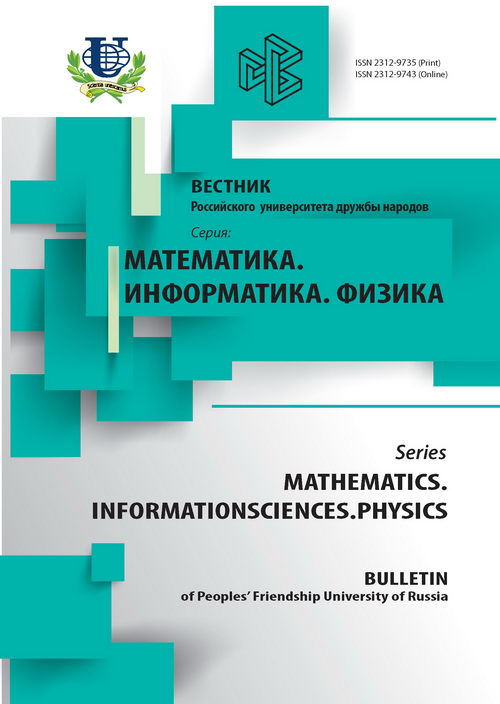No 4 (2010)
- Year: 2010
- Articles: 18
- URL: https://journals.rudn.ru/miph/issue/view/533
 5-10
5-10


About Growth of Solutions to Ordinary DifferentialEquation with the Delay Argument
Abstract
The functional-differential -order equation with unbounded operational coefficient and deviations of arguments is considered. The existence theorem of the existence of solutions decreasing rapidly compared to exponent, is proved in the article.
Discrete and Continuous Models and Applied Computational Science. 2010;(4):11-25
 11-25
11-25


 26-34
26-34


 35-47
35-47


 48-54
48-54


 55-68
55-68


 69-75
69-75


Mathematical Model of a Call-Center with Two CustomerClasses
Abstract
Most information services contact with their clients through the call-centers. In this paper,
we give a mathematical model of a call-center with two customer classes and three skillbased
agent groups. Customers of each class are served not only by the one-skilled agent
group but by one two-skilled agent group too. We propose formulas to obtain the main model
performance measures such as blocking probabilities, mean queue lengths and probabilities
of receiving service immediately. A computational example shows that the proposed model
is more effective that the model with one-skilled agent groups.
Discrete and Continuous Models and Applied Computational Science. 2010;(4):76-82
 76-82
76-82


Analysis of Two-Channel System of Service of LimitedCapacity with Buffer of Reordering and with Distributions of PhaseType
Abstract
The two-channel system of service of the limited capacity with distributions of phase type is
considered. On leaving the system there is a buffer in which there is a reordering of demands
according to order of their receipt. The matrix reccurent algorithm of calculation of the
queuing system stationary probabilities is presented.
Discrete and Continuous Models and Applied Computational Science. 2010;(4):83-87
 83-87
83-87


The Analysis of Properties of Solutions of BoundaryProblems for the Differential Equations of High Orders
Abstract
The relativistic generalization of potential model of a quarkonium leads to the solution
of a spectroscopic problem for quasipotential equations. In that specific case the problem is
reduced to the investigation of a boundary problem for the ordinary differential equation of
the terminating order with arbitrary parameter at the higher derivatives. In the work the
algorithm of investigation of boundary problems for the differential equations of high orders
is offered. The algorithm is realized with the use of system of symbolical evaluations MAPLE.
It is erected, that at → 0 some solutions coincide with the solution of the nonrelativistic
Schrodinger equation. Besides, are found out, so-called frontier layer solutions; transition of
one type of the solution (for example, the solution with one junction) in to another (the
solution without junctions). Investigations of properties of eigenvalues and eigenfunctions are
carried out at various values of .
Discrete and Continuous Models and Applied Computational Science. 2010;(4):88-98
 88-98
88-98


Mathematics Modeling of NonlinearGeneric Mechanics System in Computers Mathematic Maple
Abstract
The algorithms and set of programs for mathematical modeling, within the frame of computer
mathematics, of nonlinear generalized mechanical systems are presented. The built-insystem
of programming procedures prove to obtain numerical solutions in the form of splines,
splines-B and piecewise-defined functions. We define the spline operations as programming
procedures permitting to perform the analytic calculations over the converted numerical solutions
like over the ordinary functions.
Discrete and Continuous Models and Applied Computational Science. 2010;(4):99-111
 99-111
99-111


Moments of Observables in Quantum Measurements Modelby Kuryshkin-Wodkiewicz
Abstract
In the frame of constructive Kuryshkin-Wodkiewicz model of quantum measurements theory
problem of calculating measured moments of observables is considered. This problem is
closely related to the problem of calculating dispersions of measured values of observables,
examined in details in papers of V. Kuryshkin. Values of moments and dispersions of measured
observables are uniquely determined by quantum distribution function of Kuryshkin-
Wodkiewicz.
Discrete and Continuous Models and Applied Computational Science. 2010;(4):112-117
 112-117
112-117


Realization of Collective BehaviorHeuristic in Quantum Dynamics of Many Bodies
Abstract
We describe the ways of constructing algorithms for the simulation of many bodies dynamics
through the heuristic of collective behavior, including Feynman path integrals, Bohm
approach and the method of dynamic diffusion swarm. We discuss the adventages and drawbacks
of these methods.
Discrete and Continuous Models and Applied Computational Science. 2010;(4):118-120
 118-120
118-120


Effects of Hard Influence of Dark SectorFields on Cosmological Perturbations
Abstract
We consider Dark Sector fields evolution on the basis of dynamical equations on the background
of inflationary stage of Universe. We consider energy characteristics of Dark Sector
fields to be of the same order as perturbations of gravitation field and inflaton. Effects of
influence of Dark Sector fields on large-scale structure formation within the example of exponential
inflation are researched.
Discrete and Continuous Models and Applied Computational Science. 2010;(4):121-132
 121-132
121-132


 133-135
133-135


Vacuum Creation of Scalar FieldParticles in Conformal-invariant Theory of Gravitation. HamiltonianFormalism and Quantization of Relativistic Systems
Abstract
model of gravitation in the frameworks of the Hamiltonian (Dirac) approach is considered.
The equations, setting dependence of observable density of number of scalar particles on the
initial data and invariant parametre of evolution, are constructed in an explicit form.
Problems of unification of principles of the General Theory of Relativity (GTR) and the
Quantum Theory of Fields (QTF) within a simple example of a vacuum creation of scalar
particles in conformal-invariant model of gravitation [1-3,10-14] are considered. It is shown
that such model can describe both possible mechanism of such creation, and ways of its
generalisation to more complex models, including Standard Model (SM).
It allows to formulate some new approach to quantization of the relativistic gravitational
systems, which essence is in quantization of the phase space of initial quantities as integrals
of motion of the system, obtained by Bogoljubov diagonalization of the motion equations in
Hamiltonian formalism, and in the proof of equivalence of such quantization to transition
from classical commutative variables to their noncommutative quantum analogues.
The above described scheme can be applied to initial manifolds of any finite dimension and
topology.
Discrete and Continuous Models and Applied Computational Science. 2010;(4):136-144
 136-144
136-144


Nashi avtory
Discrete and Continuous Models and Applied Computational Science. 2010;(4):145-146
 145-146
145-146


Pravila oformleniyastatey
Discrete and Continuous Models and Applied Computational Science. 2010;(4):147-147
 147-147
147-147
















